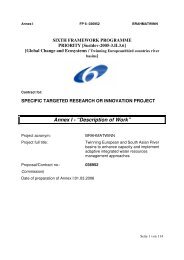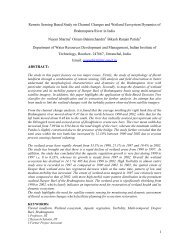WP 5 Analysis of present IWRM practices - Brahmatwinn
WP 5 Analysis of present IWRM practices - Brahmatwinn
WP 5 Analysis of present IWRM practices - Brahmatwinn
Create successful ePaper yourself
Turn your PDF publications into a flip-book with our unique Google optimized e-Paper software.
Industrial centers are mostly located close to rivers due to their high water demand. These industrial<br />
areas then establish an own water cycle: water is extracted, used, treated and discharged back into<br />
the river. Industry in the area <strong>of</strong> the Salzach is mainly chemical industry which is concentrated in the<br />
“Chemie-Dreieck”. The triangle consist <strong>of</strong> seven economic centers and altogether 25 enterprises with<br />
25 000 employees. Alone at the station Burghausen in the Salzach basin work about 4000 employees<br />
in 5 enterprises, 7 Mio.m 3 <strong>of</strong> water were extracted per year, and major part is coming from the Alz<br />
River. Most water is used for cooling purposes. The energy demand is enormous in the region.<br />
In the past the water quality was significant affected by the cellulose fabric in Hallein, but since 1999<br />
a good water quality could be secured (Water quality class 2 – low pollution level following EU water<br />
framework directive). (LAND SALZBURG 2009). A grave pollution has been observed in 1977 because <strong>of</strong><br />
the Cellulose fabric. Organizations like Greenpeace give high attention to water treatment in the<br />
chemical industry area.<br />
Today water uses are strictly monitored to avoid that they constitute a risk for environment or<br />
human health. Nevertheless groundwater in Salzburg is endangered due to fertilizers and pesticides.<br />
2.4 Related issues in the Lech basin<br />
Largest city in the basin is Augsburg with more than 260 000 inhabitants. The entire agglomeration<br />
Augsburg with a population <strong>of</strong> 500 000 is one <strong>of</strong> the most important economic centers in Bavaria. It is<br />
very important for environmental technologies, as well as for information- and communication<br />
technologies. About 20 Mio.m 3 water are needed in 2007 in Augsburg (STADTWERKE AUGSBURG 2007).<br />
2.5 Challenges for <strong>IWRM</strong><br />
In the Danube river basin actually there are no problems in respect to water quantity and water<br />
supply. With the instruction <strong>of</strong> the Main-Danube channel water is transferred to another river basin<br />
to increase water availability there. But the Upper Danube is a glacier fed catchment and as a likely<br />
climate change impact great glaciers will disappear in the next centuries and this will have an impact<br />
on the run<strong>of</strong>f regime <strong>of</strong> the river. This may affect water users in the river basin.<br />
Also water quality is basically in good condition. Waste water treatment is strictly regularized and<br />
controlled in the countries <strong>of</strong> the Upper Danube river basin. Nevertheless risks are caused by diffuse<br />
pollution sources coming from the agricultural sector in form <strong>of</strong> fertilizers and pesticides.<br />
The International Commission <strong>of</strong> the Danube River Protection is a superior authority which considers<br />
trans-boundary issues in the Danube and its riparian states.<br />
Following issues summarize future challenges for the implementation <strong>of</strong> an <strong>IWRM</strong>:<br />
• During the last 30 years decreasing water tables are observed (causes unknown).<br />
• Decreasing water quality particularly due to agriculture and industry.<br />
• Uncoordinated and heterogeneous local and international water laws and policies.<br />
• Expected large landuse changes and increasing tourism expecting an “undisturbed” landscape.<br />
• Increasing conflicts between different water users, particularly tourism-agriculture water suppliers.<br />
10





